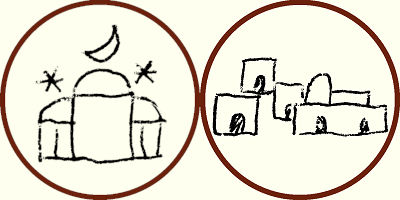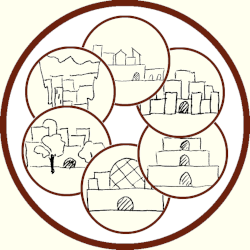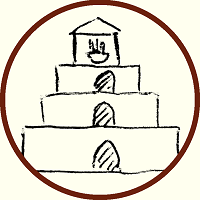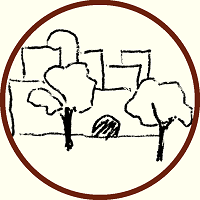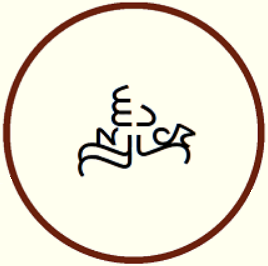HOME | DD
 blege22 — Tribes and Cities of the Tarib - 10
blege22 — Tribes and Cities of the Tarib - 10
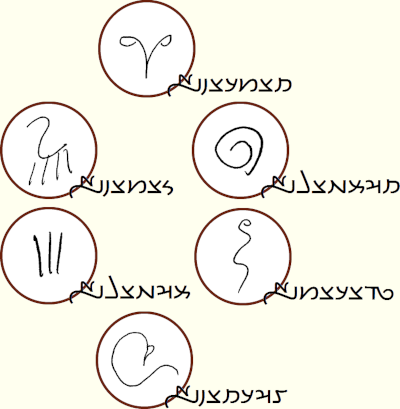
#fantasy #gimp #scanner #worldbuilding #ballpendrawing #inventedhistory #inventedantiquity #ancienttriballife #oldsogdian
Published: 2024-04-22 16:20:37 +0000 UTC; Views: 1262; Favourites: 35; Downloads: 0
Redirect to original
Description
Oshey TribesOf the thirty Taribian tribes, that worked on the canonized version of the Written nearly 2,000 years ago, six still exist today and continue to live - or live again - as nomads. They call themselves 'Oshey' ('following the old (right / true) path'), and maintain the traditions known from the stories of ancient times, collected in the Written.
After Hermil Tashrany, as a pious man, had been deified by the gods, his son Nefut took over the reins of government in Hannai in 2676 YatO, but ignored his father's large domain and the bureaucracy that organized everything in Berresh. So the Taribian Empire collapsed within years due to a lack of political, military and financial support. Some nobles in the Taribian cities, as well as some tribal chiefs and close family members of tribal chiefs, saw this decline as a sign of the gods' displeasure with the lifestyle of the successor of the empire's founder. And in view of their political decisions, also the priesthood in Harna had this opinion.
Since these dissatisfied and admonishers feared disaster in the form of the wrath of the gods if they did not take countermeasures against their better judgment, but were reluctant to use violence against their friends and relatives, they decided, after their arguments had been ignored by the majority of the Tarib, to revive the almost forgotten tribal culture, in which the Written and thus godliness were traditionally upheld. To this end, the Taribian tribes represented among the dissatisfied were, so to say, reborn as Oshey tribes and all dissatisfied urban Tarib joined one of the tribes, depending on their personal preferences or family ties. The Oshey returned to the area known as the traditional homeland of the tribes, the plateau west of the steppe.
Since Nefut Tashrany lost some important advisors and Hannaian officials in this way, he raised an army to eradicate the dissatisfied, whom he described as rebels, and who he also saw as competition to his rule over Hannai. It is said, that only the new, long and slightly curved swords of the Oshey prevented them from being destroyed during the only encounter with the Hannaian troops in 2677 YatO, near what was later called the Skull Oasis. Other accounts, however, claim that it was the distance of the Hannaian troops from their base and the inefficiency of the replacement commanders of these troops, that made the victory possible for the Oshey, who had the previous commanders in their ranks.
The Written with its religiously influenced morality determine the essential part of the true path of the Oshey, through which they define themselves, and therefore refer to all other Tarib as 'Aiashey' ('following the path of the settlement', i.e. 'townspeople'), usually using that word derogatory.
The ancient way requires not only the nomadic way of life, determined in part by centuries-old herd and tribal calendars that dictate the visitation of specific places along assigned paths and at set times of the year, but also the detailed and repeated reading of the Written, in order to internalize the values conveyed therein through this constant repetition.
To make a living, members of the Oshey tribes raise livestock and often engage in a craft that has been typical of their tribe for centuries. They maintain the historical tribal culture of the Tarib a bit like in an open-air museum - even if they are extremely serious about it. Due to the historicizing way, in which the Oshey have revived the way of life of their ancestors, the Oshey tribes are much more homogeneous than their ancestors' tribes were. And even though they would deny it, the Oshey have retained - or adopted - some urban behaviours.
For a part of the educated elite in Hannai and Taribai, in Tetraos and Letran, the Oshey actually represent the at least emotionally cherished and cultivated ideal, since this tribal culture reflects something like the 'good old days' of the Tarib, since back then the world was still in order in this northwestern part of the Oikumene. However, to most urban Tarib, the Oshey are usually either retarded camel herders or ruthless bandits, who threaten the safety of the residents of the Northern Cities. Because it is precisely in these roles that the nomadic and urban Tarib usually meet: the camel guides of the caravans through the desert south of the Northern Cities are often the Oshey, who are always dressed in black coats and headscarves - and the bandits of the desert, who only make their living through attacking these caravans, because the settlements are too well defended, usually don't dress differently.
The desertification of the area adjacent to the desert in the north and west, has progressed significantly in recent centuries, now reaching into the western highlands inhabited by the Oshey. Numerous abandoned oases along the main caravan routes between the Northern Cities and Ma'ouwat, of which hardly more than a well that has almost run dry is evidence, are showing this. This creates potential for conflict between the Oshey tribes, whose habitat is becoming increasingly restricted. For unwary travellers there is, beside the danger of being ambushed by bandits, also a good chance of getting caught between the fronts of these small wars.
*
The Oshey's relationship with the Northern Cities is ambivalent at best. The princes of the six Oshey tribes agree, that Hannai's claim to rule over the area between the Sheyshen and the southern city of Ma'ouwat, as legal successor of the Taribian Empire, is unjustified. On the other hand, the tribes benefit from the fact, that Hannai is also trying to expand in other directions and therefore regularly employs mercenaries for its wars. It is therefore not uncommon for young men from the tribes to temporarily move north to join one of the Hannaian mercenary units recruited from Oshey.
* * *
Oshey tribal symbols
Above I present the tribal symbols of the six Oshey tribes, together with the oldest written version of the tribes' names, from the time before the Taribian Empire.
These are clockwise from top:
Tashrany
The Tashrany are the falcon tribe; scholars argue, whether the barn owl was not the tribe's totem animal before the Oath. The eyes of the tribal sign are being painted over the eyebrows and the tip of the beak extending to the bridge of the nose.
The Tashrany's craftsmanship in woodworking and lacquer processing was already celebrated before the time of the Taribian Empire and remains unsurpassed to this day.
*
Temhaly
The Temhaly are the Capricorn tribe. The stylized horn is being painted in the middle of the forehead with more or fewer coils, according to the tradition of one's own family.
The Temhaly are considered the best carpet weavers of the Tarib.
*
Darashy
The Darashy are the Serpent Tribe. The snake's body is being painted on the bridge of the nose, with the head just above the eyebrows.
The Darashy's totem animal is Ulamar, a fire-breathing serpent, who is also occasionally invoked by the metalworkers of other tribes.
The blacksmiths - and the forges - of the Darashy are proverbial. Of course, it is said to have been a blacksmith from this tribe who invented the long swords with which the Oshey defended their lives against the attack of Hannai after the fall of the Taribian Empire.
*
Sertany
The Sertany are the Scorpio Tribe. The tail with the poisonous sting of this animal is being painted just above the bridge of the nose, curved to the right or to the left, depending on the tradition of one's own family.
*
Mehaly
The Mehaly are, depending on the translation of the oldest sources, the wildcat or panther tribe. The three lines that represent a swipe of the paw are being painted in about the length of a finger vertically from the eyebrows to the hairline on the forehead.
*
Yoshany
The Yoshany are the horse tribe, they paint the stylized horse over the bridge of their nose.
The Yoshany are famous for their horse breeding and their knowledgeable handling of the animals.
* * *
The German text I wrote in 2023 for my website, the English version of the text was made by me in 2024 with help of the Google Translator (for enhanced vocabulary) and 'Language Tool' (to check spelling).
The graphics I drew in 2023 with a ball pen, they should show, how the six Oshey tribes paint their totem animals on their foreheads. I scanned the drawings and edited them moderately in GIMP, e.g. put neat circles around, and added the name of the respective tribe in the 'Old Taribian scripture', which is impersonated by the Old Sogdian letters. For that I used the font 'Noto Sans Old Sogdian' (Copyright 2012 Google Inc. All Rights Reserved.) All Google fonts can be freely used in graphics and be displayed public on websites under the SIL Open Font License Version 1.1 von 2007 (openfontlicense.org/ ).
Related content
Comments: 9

👍: 1 ⏩: 1

👍: 1 ⏩: 0

👍: 1 ⏩: 1

👍: 1 ⏩: 1

👍: 1 ⏩: 1

👍: 1 ⏩: 1

👍: 1 ⏩: 1

👍: 1 ⏩: 1

👍: 1 ⏩: 0
